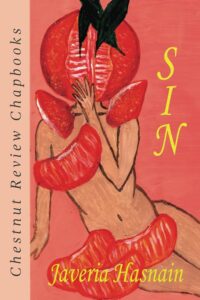The Manananggal as Mythmaking
Melanie Manuel
December 12, 2023
I have spent many drafts trying to decide on where to begin on the topic of the manananggal and its role in Filipina American or Pinay (I’ll use this interchangeably) poetry. I wondered whether I should define her (if I even can) or if I should mention her origin (the very bare minimum of which I know). I wondered if I could even do this essay justice because of the manananggal’s complexities. She is more than folktale meant to placate young children into listening to their elders. She is more than a cautionary tale for young girls to steer clear from breaking away from societal norms. She is a legacy, a kind of framework even, for poets to follow when approaching their work and the very task of mythmaking.
At her surface, the manananggal is best described in Maximo D. Ramos’s The Aswang Complex as “an attractive woman by day, buxom, long-haired, and light-complexioned. Its tongue is extended, narrow, and tubular like a drinking [original text says ‘dinking’ but I presume this is a typo] straw —but not pointed like the vampire’s— and it is capable of being distended to a great length. At night the monster discards its lower body from the waist down and flies or floats or glides out” (xviii). On these evenings, she searches for food, typically pregnant women and infants; sometimes, depending on the story, men and children. She is almost always characterized as a woman, sometimes a recluse, a housewife, anything that can be considered non-traditional as well, etc. The commonality is someone who is not highly regarded in society. However, to fully understand her origins, I must briefly mention the Babaylan of the Philippines. Prior to Spanish colonization, the Philippines once believed in animism, the idea that all inanimate and animate objects have a soul. The Babaylan were considered shamans that consisted of women and transgender women. They were highly regarded as healers, mystics, and most importantly, leaders. This had come as a shock for the Spanish priests sent to the Philippines to encourage and later enforce the conversion from animism to Catholicism because it was seemingly unheard of for women to lead or hold any kind of autonomy. One of the ways this shift became possible was due to the demonization of the Babaylan, which eventually became the creation of the manananggal.
While this is not new news, it is not well-known news either. Many Filipinx Americans today are not even aware that the Philippines did not always practice Catholicism or there are sets of deities between the regions (Tagalog, Visayan, Illocano, etc.). Even so, these stories are not completely lost. Despite the fact that a woman-of-color (WOC)’s erasure and silencing are no surprise in the face of colonialism or patriarchy, even so, pockets of her continue to exist through poetry and stories. Every telling and retelling keeps her story alive. Sometimes her story gets made anew by the generations that follow. Sometimes they exist in superstitions, like when we say, “Tabi, tabi po” or “passing through” in a graveyard or forest so as not to disturb the spirits or upset the duwendes who take refuge in those spaces. Usually, they take on lives of their own, shaped by its teller however they see fit. This is mythmaking.
For Filipina American or Pinay poets (I’ll use these terms interchangeably), the manananggal represents a woman erased, silenced, demonized, reduced, empowered, angered, untethered, unmoored. The list could go on and on. The point being Pinay poets use and shape the manananggal by their intentions. They recreate the manananggal’s myth. Although I could go on for pages about Pinay poets who use the manananggal as a form of mythmaking, I will limit myself to the following poets: for earlier takes, Rachelle Cruz, who depicts her manananggal as a lost soul trying to find its way in a new land; Barbara Jane Reyes, whose manananggal is angry and misperceived; while more contemporary takes, like Danni Quintos demonstrates hers as a justification for who she is as someone who grew up in a predominantly white area; Maria Bolaños, who pays homage to those who come before and is haunted by this legacy; and finally, myself, with mine acting as a mentor, an ate, through the hardships of life. Each of us use the manananggal differently, albeit along a similar throughline of expressing ourselves and who we are in some capacity. This then creates a new myth in every iteration of the manananggal, allowing her own story to live on and take shape, and simply exist, which really, is the heart of every poem anyway.
Although this is not the first time someone has used the manananggal as a persona, and in fact, Barbara Jane Reyes’s To Love as Aswang came out just two years before this 2017 publication, my journey toward understanding the manananggal began with Rachelle Cruz’s God’s Will for Monsters. This debut collection features a manananggal trying to find its way in a new land, having traveled from the mythic homeland of the Philippines to an all too familiar Hayward, California. As someone who grew up in the South Bay (Milpitas/San Jose) area, it was mind blowing to see poems located so close to home. It felt like a fantasy brought to real life. I was transfixed by this, and the very creature traversing this space. Her inclusion of Ramos’s anthropologic description of the manananggal made her feel more realized, despite being shared as a series of erasure poems. This decision felt all the more important to look carefully and parse the language of what was left.
In one of the definitions, Cruz mentions the manananggal’s intention of feasting on pregnant women and infants whenever she detached from the torso and hid away her bottom half in a safe place. The poem, “How to Prepare Your Husband for Dinner” does away with that idea by demonstrating that the manananggal no longer adheres to given definitions and acts on its own volition. After all, her very existence rebels against our expectations: Cruz’s manananggal no longer exists in the Philippines, is no longer a folktale told by her mother to get her to obey, but a creature gathering its bearings in a strange, new land that does not necessarily believe in her. It’s discombobulating, but so is growing up and coming into your body, your own personhood. Meanwhile, Reyes centers her works, Diwata and To Love as Aswang around her manananggal’s anger and accepts that it will perpetually be misperceived, having already accepted who she is and what she is capable of.
As mentioned, Barbara Jane Reyes’s manananggal is aware of what she is and what she can do, having already accepted her own other-ness and working with the anger that comes with it. Where Cruz’s manananggal is coming into its own, Reyes’s manananggal already knows. This is not to say one poet’s manananggal is better than the other, but in fact, both demonstrate a specific kind of strength, and a large amount of anger—understated and outright stated. The respective manananggal of Reyes’s Diwata (2010) and To Love as Aswang (2015) share a similar voice, steady yet powerful; while Diwata’s concluding poem, “Aswang” comes across as a manifesto for what to expect in poems to come, To Love as Aswang dares the reader to challenge them and their thirst for justice. In To Love as Aswang, the manananggal strikes against those who have wronged her or enacted injustice against other Filipinas, wanting to highlight the violence done against brown bodies and call people to action about it. No longer a matter of satiating a personal hunger, but a collective one. This then expands our image of the manananggal, reminding us that she is allowed to be a morally grey character, for she exists to neither be a wholly good or wholly evil creature, but perhaps somewhere in between that space. That is to say, she is simply allowed to exist. Similarly, Danni Quintos’s manananggal serves as a justification for her own existence, not to the same degree, but this shift toward a more contemporary take of the manananggal reifies the importance of acknowledging what has come before so you may move forward.
Danni Quintos’s manananggal appears in the “Myth” section of her collection, Two Brown Dots, in which she directly compares the creature to herself. Two Brown Dots (2022) is autobiographical, taking inspiration from Quintos’s childhood as a Filipina American growing up in a predominantly white area and discussing its impact on her. Although her entire collection is not dedicated to the manananggal, it is important to discuss her poem as it coincides with her experience growing up, and it is in this juxtaposition that we discover an important idea about the manananggal. In the poem, “Self-Portrait as Manananggal,” Quintos centers her speaker as the eponymous creature in a self-portrait poem. She reminds the readers of lore we already know, such as how the manananggal splits in two, comes back together, must protect herself from salt and garlic, and how she flies high above the sky, bare for all to see, but most importantly, for herself. This is a personal touch from Quintos as her collection fixates on her body and how it has been scrutinized and digested by others; for once, this is her opportunity to exist for herself and no one else. It’s a self-aware poem that hinges on our understanding of the manananggal’s conceit—as a woman separated, scrutinized, and Othered. Where Cruz and Reyes embody the manananggal, Quintos demonstrates a sense of becoming the manananggal in the contemporary world. Quintos’s take juxtaposes this centuries-old creature with items of modernity like Photoshop and billboards, and how these things influence our consumption of her. Even so, these moments say more about the timelessness of the manananggal than her ability to be swallowed whole by the arbitrary. In other words, the manananggal is beyond what we simply see, and her impact transcends that of the tangible. Quintos allows her to exist and soar off the page, punctuating the poem with an ellipsis, as if to say, there is much more beyond us, waiting to be said. And perhaps, what goes beyond us means looking back and paying homage to what has come before. Maria Bolaños’s manananggal does exactly this—the idea of examining the past allows for the idea also means that we are actively thinking of our future.
The manananggal of Maria Bolaños’s SANA (2022) is by nature like the manananggal that has come before, aware of its legacy, she harkens herself to this and seeks a larger understanding of the world, herself. Again, not a dedicated collection on the manananggal, but a duo of poems that highlight her and her power, allowing both myth and reality to collide, past and present to meet; it is a kaleidoscopic unearthing of what is to come in the rest of Bolaños’s chapbook. In “Portrait of an Artist as Manananggal (I)” and “Portrait of an Artist as Manananggal (II),” Bolaños acknowledges that her manananggal comes from a long legacy of other writers who have had similar conceits by using doubly using the cento and ghazal form. She borrows lines from Isabel Garcia-Gonzales’s “Blessed Fruit,” Natalie Diaz’s “Lorca’s Red Dresses,” Emma Lazarus’s “The New Colossus,” a Wikipedia entry on the Manananggal, Audre Lorde’s Sister Outsider, and an excerpt of a letter by Gertrude Stein; while using the end word “monster” to echo that of the manananggal’s legacy as that very thing that goes bump in the night. But there is much to learn and understand, between the lines, how each couplet flies across the page, taking up every inch before breaking into the next stanza.
It is similar to that of her manananggal, who seeks being heard, acknowledged, for the entirety of SANA concerns itself with bringing past and present to the light in hopes of creating a new kind of future, a new kind of understanding. This manananggal has come into its own skin. Both a grief and found poem, “Portrait of an Artist as Manananggal (I)” and “Portrait of an Artist as Manananggal (II)” serves as a mirror, an understanding, of Bolaños as a Pinay poet as the poem itself stands as a self-portrait poem as well, and really, I find that I relate to this conceit. There is a tragedy in knowing one’s self and the colonial history we come from. There is an echo of those who come before, who have written about the things we write about. There is no harm in paying homage to them. In fact, there is power in doing so, in acknowledging that we can carry on their voices and create our own. Bolaños’s poem reminds us of the demonization of our power and shows us we can reclaim our power. In fact, any manananggal poem shows we can take that power back and harness it as our own. These bodies we carry are ours and ours alone. For that reason, I point to my own work and my own fixation with the manananggal. How she carries multitudes that I am still trying to parse to this day.
My manananggal is a culmination of the other manananggal that have come before—namely Rachelle Cruz and Barbara Jane Reyes. Their fearless and fearsome renditions of the manananggal struck me for what Pinay poets could be and what their work could stand for. The idea of myth coming to reality, becoming a new kind of canon felt like a breath of fresh air, a possibility that went beyond what I could even conceive of Pinay poetry.
In an interview with The California Journal for Women Writers (TCJWW), Cruz once said: “I was interested in using the Aswang figure to explore gender expectations, the body (the split, the severed, the gendered, the racialized, the idea of a ‘whole’ body), and the search for knowledge, historical and body knowledge.” This fixation of the body and its autonomy are no strange matters for Pinay poets centering the manananggal in poetry. The physical separation of the manananggal’s body is nothing short of an allusion to a woman’s mental separation between personal self and outward self. A manananggal’s lower half must be hidden away, kept safe from the threat of salt or holy water, because if either of those things come into contact with it, then she is unable to become whole again. In other words, she must keep a part of herself safe. There’s a careful consideration of this in Cruz’s work, not so overtly in the others I’ve discussed, but I personally have centered my lore around this idea of keeping oneself safe.
Much like Cruz and Reyes, I have clung to a similar notion of using the manananggal’s voice to speak through heartbreak, anger, comfort, and frustration. This has made approaching personal topics bearable because of how I am able to look at them in different angles through the manananggal. Sometimes I write from a personal place. I find that my best work comes from my vulnerability. But sometimes I run the risk of getting too close to the subject and getting too sentimental to where I miss what the poem really wants to be because I fear that missing certain details or emotional beats will detract from the experience. However, in taking on the manananggal, especially in the face of heartbreak poems, I find that I am able to best communicate these experiences without getting lost in the actual memory. For me, she is more so a mentor, an ate (older sister), if you will. Her voice is knowing, reproachful, exasperated, and nurturing—all the things I have wanted in an ate despite being the eldest daughter in my family. My manananggal gets feeling lost and hurt, she allows for me to feel these things without falling too far deep into those emotions, and she also allows me the safe space to be myself—as someone who presents themselves as strong and resilient outwardly, it’s hard to show my inner vulnerability without feeling like this is a weakness. It isn’t, but it feels that way. My manananggal allows me to feel and show her vulnerability, however, reminding me that it is okay to keep parts of myself. The aspect that the manananggal hides her bottom half, safe and away, is an important component to the way I have shaped her myth. Sometimes this hidden part is vulnerability, is sexuality, is the part of yourself that you only allow a select few to see, and it’s more potent this way. There’s something to be said about having this complex creature drive the work.
I lean into the idea that her transformation comes from the inevitable separation you feel from your inner and outward selves. There’s no avoiding it, and in one of my earlier drafts of the manananggal, she comes to the poem’s speaker after a heartbreak, even after warning herself against falling into someone that would inevitably hurt her, knowing that this person would and still the speaker does so anyway and finds herself amidst metamorphosis. Her heart is ripped out her chest, and perhaps she is separated from the waist too. It’s violent and visceral, but that’s what heartbreak feels like. There’s a pain in it that rips you into a new person. To me, that is the manananggal. Sometimes she scolds me for making the same mistakes. Sometimes she encourages me to lean into being fearsome and fearless. She guides me through the ups and downs, reminds me that I am not alone. She operates on multitudes. She even hails from a legacy of those who have come before and floats alongside others like Quintos and Bolaños.
On a craft level, I don’t believe there is a set formula to how a poet uses the manananggal. There is no singular form that best encapsulates her. I have seen her written in prose, couplets, ghazal, cento, erasure, columns, and I’m sure there are even more ways that I have yet to see. There are multiple ways in which someone can use her figure, whether as an expression for one’s need to understand their origins, an expression for anger, an expression to justify one’s place in the world, and an expression for the complexities of what it means to write now, knowing the histories and myths that we know now, paying homage to what came before and trying to make a space for ourselves in world that often tries to silence our voices in favor of stories that adhere to the plights of those who request our words become digestible for them to understand. If I were to even begin to turn the manananggal into a formula for others to use, I would ask someone to consider a persona they have always wanted to use. How does this voice speak? Is it angry? Frustrated? Sad? Happy? What motivates this voice? Consider where this voice comes from. Does it echo one that has come before? Take that voice. Take its source. Then, converge this with some metamorphosis. Watch as it becomes something outside of your own control. Let it.
I think the best way to conclude this is with a quote from Rachelle Cruz, from that same interview with TCJWW: “…I believe the Aswang belongs to everyone and to no one. She is a shape-shifter for a reason, and I don’t think it’s possible for any one writer to pin her down (I don’t think she’d want to be anyway)…” After all, the manananggal is more than a creature told by our elders to act in submission. She is more than a voice or a persona to take on as we write our poems.
Pinay poets embody and become the manananggal as a form of understanding themselves and their histories—it’s mythmaking at its finest. There is no one set way to define her because she operates on so many levels, some conceivable, some not. She presents us with a way of writing for the self, for allowing ourselves to be, without the expectations of others to police, silence, or erase that. I have always been inspired by those who come before me as they are the same ones who have shown me that my voice matters too. For that, I thank Rachelle Cruz and Barbara Jane Reyes for introducing me to the manananggal and her power and potential, and am grateful for poets like Danni Quintos and Maria Bolaños for unabashedly writing the manananggal in their recent releases as a show of what the possibilities could be. I know there is more to come. More myths to write. I myself find the itch to do so. And I hope those who read this will too.






